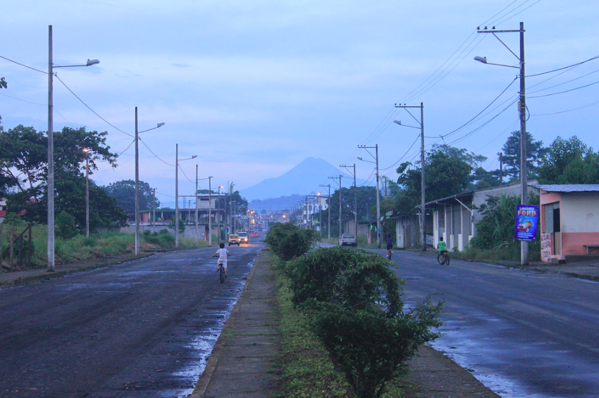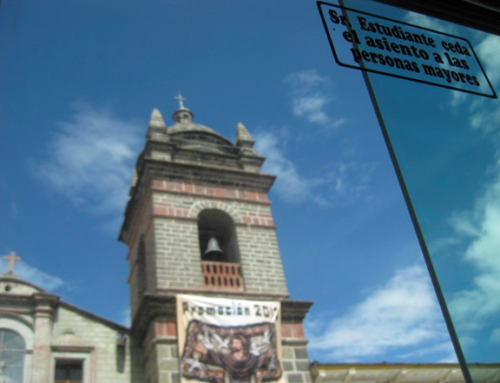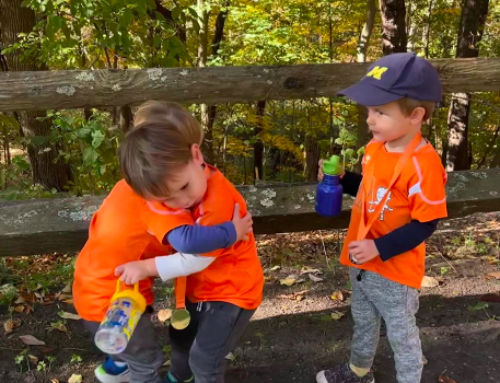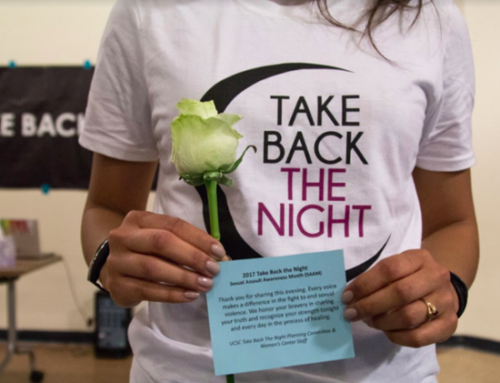One afternoon, I was looking through videos on my phone with a few of the children and teenagers from the Kichwa community of Chawpishungu in Napo, Ecuador. I had filmed several at the Yasuní Biosphere Reserve, known as one of the most biodiverse places on earth. There, my colleagues and I encountered an orphaned tayra, an omnivorous animal in the weasel family, which had been informally adopted by field station staff. Although many of these young people spoke Kichwa, they could not identify the animal in the videos. “¿Qué es?” (What is it?) one teenager asked me in Spanish. Their grandmother Serafina, at the time in her late 60s, recognized it immediately as a tuwi, which was common during her childhood. In the intervening decades, however, expanding roads, agriculture, mineral exploration, and settlement reshaped many of the forests near their community. Although some game could be found nearby, many animals, including the tuwi, were encountered much less frequently, other than in stories told by elders. The young Kichwa men’s grandfathers and fathers had spent considerable time hunting in the forest near their homes, but the opportunity to spend long periods of time pursuing game was no longer a regular feature of many young men’s daily lives during my research.
Language “endangerment” and revitalization rank alongside the effects of extractive industries as major concerns for Indigenous communities of the Americas. These concerns are more closely related than many realize. This became clear to me during time spent in Napo, where extractive and settler colonialism have transformed local environments, social relationships, and language practices in complex ways. Environmental disruptions, like the introduction of roads, deforestation, oil and mineral extraction, poaching, and other pressures facing many communities, are not direct causes of language shift (Muehlmann 2016). But they can have significant related effects on language, as they reshape the interactional world available to residents. For some people, a rural subsistence lifestyle is either no longer possible given environmental constraints, or no longer desirable in the context of new opportunities for education and labor (Shenton 2019). Languages might shift as children and adolescents are encouraged to use Spanish among their peers at school or by their parents to avoid discrimination. Both language practices and environmental knowledge are changing as the plants and animals their elders once interacted with are no longer found close to children’s homes.
I have found it easier to mobilize concern from outsiders for one of these issues than the other. In introductory anthropology classes, my students are usually much more aware of environmental activism than language activism. Eliciting similar levels of care for endangered languages as for endangered animals or ecosystems remains difficult. Reframing “language endangerment” as “language oppression” (Taff et al. 2018; Roche 2020; Albó 1979) may help to articulate new forms of care—here conceptualized as empathy, concern, and engagement—for the social conditions of both languages and the people who speak them.
From endangerment to oppression
Language endangerment has been a topic of considerable scholarly interest since at least the 1980s, when analogies to species endangerment were first mobilized. The situation remains troubling, as most estimates suggest that approximately 40% of the 7000 or so languages spoken today are “endangered.” Concerns about language shift expressed by community members and embedded in ethnographic texts suggests that many had begun to raise the alarm well before linguists. Despite decades of intervention and research, many Indigenous language communities still find speakers shifting away from their heritage language(s) towards dominant languages. This is the case in the Ecuadorian Amazon, where a language shift towards Spanish continues in many Kichwa households, despite the introduction of language standardization, education, and revitalization programs in bilingual school programs. Paradoxically, such programs created new tensions in Kichwa language politics that may discourage people—particularly those who do not command the new standard—from using regional, heritage varieties of Kichwa.
This series asks authors to consider what it means to care in an unsettling world—a world marked by unrest, precarity, crisis, and breakdown. Yet, this is the world that has been made by settler colonialism and imperialism. As philosopher Kyle Whyte suggests, “by seeking to establish their own homelands, settler populations are working to create their own ecologies out of the ecologies of Indigenous people” (2018, 135). Shifting baselines may render the effects of settlement invisible to many of us (settlers), as the surrounding infrastructure comes to feel natural. The landscapes we traverse daily, the names of places, and the relationships we hold to the land are all traces of settlement. I am writing this from Tali Tsisgwayahi, or Two Sparrows Town, a Cherokee village upon which Western Carolina University was built. Perhaps it is not that the world is unsettled, but that more people are becoming aware of the contemporary manifestations of settlement in many regions of the world.
From this perspective, language endangerment is not an agentless process. Linguists have sometimes likened endangered languages to patients, upon whom the concerned linguist-as-doctor would act (Fishman 2001, 1). But if linguists are doctors, then our patients are the survivors of violent crimes, not tragic victims of fate. This is a point that has been made repeatedly by Indigenous scholars. Jenny Davis (2017) describes two related phenomena in studies of endangered languages. The first is a tendency towards “linguistic extraction,” in which languages are separated from the people who speak them and their sociopolitical histories. The second is a move towards “the erasure of colonial agency,” which deflects the responsibility of language shift away from settler actions onto language communities, who are said to be “killing” or “abandoning” their languages (Davis 2017, 42-43).
Most people do not just wake up one day and decide to abandon their language in favor of another. Rather, it is oppression of the social and interactional worlds that once sustained livelihoods and languages that is often at stake. Such oppression may be environmental. According to Whyte (2018, 133), the transformation of Anishinaabe ecologies of “collective continuance” occurred through the transformation of landscapes, as well as the use of carceral measures like boarding schools, meant to separate people from their families, languages, and cultures. These are processes that have played out repeatedly across the Americas, including in Napo.

The main street of Archidona, Ecuador. Urbanization and settlement are ongoing transformational processes in the western Amazon. Photo credit: Georgia Ennis.
From Ecocide to Ethnocide
Kichwa residents of Napo did not just wake up one day and decide to speak Spanish, nor to embrace new economic systems. They did, however, make strategic choices in changing environments. A close relationship between the Ecuadorian state, various oil companies, and Evangelical and Catholic missionaries supported increased settlement in the region since the 1920s (Muratorio 1991, 165–67). These are processes that Kichwa people at times sought to use for their own benefit, evident in communities who took advantage of government agricultural and livestock programs to claim land rights (Erazo 2013). Such decisions occurred in the context of dispossession of traditional territories (Macdonald 1979). This raises questions regarding the degree to which many people may actually desire to raise cattle, an icon of environmental destruction elsewhere in the Amazon. Similarly, the shift towards Spanish is occurring as rural, subsistence lifestyles become less tenable for many people in Napo. Some Kichwa people do continue to speak Kichwa in urban areas, but there are challenges to this on several fronts. Although language activists are opening new spheres for Kichwa in politics and media, ongoing discrimination from Spanish speakers, the dominance of Spanish in most sectors of public life, and a history of Spanish-only education in both boarding and day schools encourages many people to use Spanish in more urban contexts.
Environmental destruction is a clear form of settler oppression, which has further effects on cultural and linguistic practices. In recent decades, environmental pressures have only increased in Napo. In the spring of 2020, a landslide ruptured three pipelines in Napo, which run alongside the Coca River. Thousands of gallons of crude oil poured first into the Coca and then the Napo. According to Eduardo Kohn and Manuela Picq (2020), this was a case of ecocide—the deliberate or negligent destruction of the environment, but “it [was] also potentially genocide,” as it destroyed the ecosystem upon which people depended for food and water. It is further a form of ethnocide, whether deliberate or negligent. The ecosystems that once sustained Indigenous economies, cultural systems, as well as languages and domains of linguistic knowledge, are increasingly threatened.
While oil extraction is a highly visible issue, it is not the only environmental problem affecting daily life in Napo and neighboring provinces. In 2021, a global shortage of balsa wood—used in wind-power turbines—led to an increase in illegal logging across the Ecuadorian Amazon (Cazar Baquero 2021). For years, unregulated gold mining steadily grew in the region, exploding in 2022 (Gabay 2023). Due to this activity, branches of two local rivers died, significantly impacting neighboring communities, many of whom depend on local rivers for water and food. Environmental disruption does not determine language change, but it does reorder the daily experiences and social relationships that once sustained a linguistic code. Such re-orderings are observable in the ongoing shift from Kichwa to Spanish, as well as in the erosion of regional environmental knowledge.
Who cares? Insiders, Outsiders, and Forms of Care
What does it mean to care for Indigenous and otherwise minoritized languages in these times? As a scholar of Euro-American descent, I have grappled with this question for years. Do I even have a right to care about languages not my own? As Jane Hill (2002) and other scholars have noted (Davis 2017; Perley 2012; Kroskrity 2011), linguists tend to appeal to the symbolic value of these languages for humanity. There is a great deal to learn about the possibilities of human language and interaction from the diversity of the world’s languages. But those languages are also the very real systems of communication of the people who speak them. Our first concern should be for the people affected by language change.
Not all communities respond in the same way to the experience of language shift. Linguist Salikoko Mufwene (2017, e135) has suggested that “language shift can […] be interpreted as an adaptive response to the changing socioeconomic ecology” surrounding speakers. For Mufwene, people may have various emotional responses to such “adaptive” decisions, not all of them negative. But as anthropologist Bernard Perley has pointed out, for many, forced language shift is “traumatic and tragic” (2012, 137).
My experiences in the Amazon suggest that language change is an incredibly emotional subject. I think often of a young Kichwa woman who I met at a community party. “They tease me now because I don’t speak Kichwa,” she told me as she began to cry, “but no one ever taught it to me.” I think as well of a grandmother who remarked, “She isn’t listening,” as she turned sadly away from a granddaughter who demonstrated little interest in stories told in Kichwa. The rupture of such relationships is traumatic and tragic. Engaging with people who experience these ruptures is emotionally moving. Perhaps what it means to care as an outsider, then, is to develop empathy for the people experiencing these traumas and to recognize what role(s) we might play—however distant they might seem—in perpetuating them. We may be much closer to environmental disruption than we realize, for instance, when 1 in 9 gallons of fuel used in California is estimated to come from the Amazon. Even more so, when California produces and ships a significant percentage of food in the United States. This places language activism within the constellation of other forms of social justice, like environmental justice, which seek to recognize and repair harm.
A new generation of Kichwa activists is now drawing attention to the effects of mining and other forms of environmental harm in their communities through social media. Many also discuss the need for cultural and linguistic rights and reclamation. In Napo, I found that young people are eager to relearn and reclaim Kichwa, but that many feel socioeconomic pressure to engage more frequently with dominant languages like Spanish and English.
Contributing to a society in which Indigenous languages are economically and socially viable resources for their speakers might be one immediate intervention. Investing in the efforts of learners and teachers economically would significantly support language reclamation programs, as would trying to learn these languages ourselves—if communities are comfortable with sharing them. For anthropologists, this also includes compensating Indigenous interlocutors, colleagues, and teachers fairly and fully for the time they provide in facilitating our research and learning. It may also mean re-thinking approaches to research design and scholarly authorship to recognize and value the input of the people who make such work possible. More broadly, it means recognizing our own complicity in the structures that continue to harm speakers, their languages, and the place we all live together.
References
Albó, Javier. 1979. “The Future of the Oppressed Languages in the Andes.” In Language and Society Anthropological Issues, edited by William Charles McCormack and S. A. Wurm, 309–30. The Hague: Mouton.
Cazar Baquero, Diego. 2021. “Indigenous Amazonian Communities Bear the Burden of Ecuador’s Balsa Boom.” Translated by Maria Angeles Salazar. Mongabay Environmental News, August 17, 2021, sec. Environmental news. https://news.mongabay.com/2021/08/indigenous-amazonian-communities-bear-the-burden-of-ecuadors-balsa-boom/.
Davis, Jenny L. 2017. “Resisting Rhetorics of Language Endangerment: Reclamation through Indigenous Language Survivance.” Edited by Wesley Leonard and Haley De Korne. Language Documentation and Description 14: 37–58.
Erazo, Juliet. 2013. Governing Indigenous Territories: Enacting Sovereignty in the Ecuadorian Amazon. Durham: Duke University Press.
Fishman, Prof. Joshua A. 2001. Can Threatened Languages Be Saved?: Can Threatened Languages Be Saved? : Reversing Language Shift, Revisited : A 21st Century Perspective. Bristol, United Kingdom: Channel View Publications.
Gabay, Aimee. 2023. “Ecuador: Indigenous Villages Fight ‘Devastating’ Mining Activity.” Al Jazeera, February 15, 2023, sec. Environment. https://www.aljazeera.com/news/2023/2/15/ecuador-indigenous-villages-fight-devastating-mining-activity.
Hill, Jane H. 2002. “‘Expert Rhetorics’ in Advocacy for Endangered Languages: Who Is Listening, and What Do They Hear?” Journal of Linguistic Anthropology 12 (2): 119–33.
Kohn, Eduardo, and Manuela Lavinas Picq. 2020. “An Oil Spill in the Time of Coronavirus.” Al Jazeera, July 14, 2020, sec. Opinion.
https://www.aljazeera.com/opinions/2020/7/14/an-oil-spill-in-the-time-of-coronavirus/.
Kroskrity, Paul V. 2011. “Facing the Rhetoric of Language Endangerment: Voicing the Consequences of Linguistic Racism.” Journal of Linguistic Anthropology 21 (2): 179–92.
Macdonald, Theodore. 1979. “Processes of Change in Amazonian Ecuador: Quijos Quichua Indians Become Cattlemen.” Ph.D., United States—Illinois: University of Illinois at Urbana-Champaign.
Muehlmann, Shaylih Ryan. 2016. “‘Languages Die like River’s’: Entangled Endangerments in the Colorado Delta.” In Endangerment, Biodiversity and Culture, edited by Fernando Vidal and Nélia Dias, 41–61.
Mufwene, Salikoko S. 2017. “Language Vitality: The Weak Theoretical Underpinnings of What Can Be an Exciting Research Area.” Language 93 (4): e202–23.
Muratorio, Blanca. 1991. The Life and Times of Grandfather Alonso, Culture and History in the Upper Amazon. Rucuyaya Alonso y La Historia Social y Económica Del Alto Napo, 1850-1950. New Brunswick, N.J.: Rutgers University Press.
Perley, Bernard. 2012. “Zombie Linguistics: Experts, Endangered Languages and the Curse of Undead Voices.” Anthropological Forum 22: 133–49.
Roche, Gerald. 2020. “Abandoning Endangered Languages: Ethical Loneliness, Language Oppression, and Social Justice.” American Anthropologist 122 (1): 164–69. https://doi.org/10.1111/aman.13372.
Shenton, Jamie E. 2019. “Strong Kichwa Women Are Made, Made Up, and Make Others: Feminist Theory Meets Amazonian Ethnography of Gender, Bodies, and Social Change.” Anthropological Quarterly 92 (1): 5–34. https://doi.org/10.1353/anq.2019.0000.
Taff, Alice, Chee Melvatha, Jaeci Hall, Martin Kawenniyóhstha Nicole Hall, and Annie Johnston. 2018. “Indigenous Language Use Impacts Wellness.” In The Oxford Handbook of Endangered Languages, edited by Kenneth Rehg and Lyle Campbell, 862–83. New York: Oxford University Press.
Whyte, Kyle. 2018. “Settler Colonialism, Ecology, and Environmental Injustice.” Environment and Society 9 (1): 125–44. https://doi.org/10.3167/ares.2018.090109.
Georgia Ennis is an Assistant Professor in the Department of Anthropology and Sociology at Western Carolina University. She is currently at work on the manuscript for Rainforest Radio, which explores the interconnections between biotic, linguistic, and media ecologies in the reclamation of Upper Napo Kichwa language and culture.




